Inside Wilton's Music Hall
To visit Wilton’s Music Hall for the first time is to discover something new about London.
Hidden down an alley way in the heart of London’s East End, Wilton’s at first glance is just a wooden doorway surrounded by a facade of peeled paint and worn stone.
But inside lies a gymnasium-sized mid-nineteenth century auditorium, once a rowdy hub of Victorian popular entertainment, where sailors and their sweethearts would carouse to the leading Music Hall acts of the day. During the 1860s and 1870s, the theatre saw tightrope walkers, the first British can-can show, and performances by artistes such as Champagne Charlie, one of the first music hall acts to play to royalty, now a resident of Abney Park cemetery.
In the main hall the sense of past is palpable. You can imagine dock workers standing by the cast iron barley-twist columns, or canoodling up in the gallery. The original stage is vertigo-inducing, made to accommodate an audience of top hat wearers, and on the ceiling you can see where a crystal chandelier with 300 gas jets once hung, ventilating the hall from the rising plumes of tobacco smoke.
The hall has recently undergone substantial repair work, though you wouldn’t realise it by the bare brick walls and furnishings. “The hall is finished and is exactly how we want it to be,” Wilton’s Oona Patterson insists. “We may still have holes in the roof but whereas they once were real they are now preserved. It’s typical East London shabbiness – but I’d like to think we were there first.”
Although a significant period, the 30 years Wilton’s spent as a music hall was relatively short. In 1888 the building was bought by the East London Methodist Mission, and became a focus for efforts to alleviate extreme poverty and improve living conditions. During the Great Dock Strike of 1889, a soup kitchen was set up that provided a thousand meals a day to the starving families of dockers.
The Methodist Mission stayed open for nearly 70 years, surviving the Blitz and witnessing the Battle of Cable Street in 1936. But after the Second World War the building fell derelict and was scheduled for demolition before a campaign supported Sir John Betjeman, Peter Sellars and Spike Milligan managed to save it from the wrecking ball.
The next turning point in fortune came in 1997 when a newly reopened Wilton’s staged a one-woman performance by Fiona Shaw of T.S.Eliot’s The Wasteland. The faded grandeur of Wilton’s provided a perfect setting for the poem and put the venue on people’s radar once more.
The threats of closure and demolition now in the past, Wilton’s is in the midst of addressing the long term structural problems with the building. Back in 1850, founder John Wilton had a vision for a ‘Magnificent Music Hall’ which consisted of buying five terraced properties, knocking them through, and building a music hall in what was essentially their back gardens.
The result was a unique structure – few theatres have the main entrance to the auditorium behind a staircase. But it also created some unique structural problems: namely, the auditorium and the houses it backs onto are not a perfect fit. From one of the office rooms you can see clear space between the back wall of the houses and the hall.
“It looks pretty cool, the way the light comes through, but in the long term it’s not ideal – there are a lot of leaks. What we’ve previously been able to do is to make it as strong as we’ve needed to continue using it, but it was never going to be sustainable,” says Patterson.
From this summer until autumn next year Wilton’s, while remaining open with a full programme of events, will be undergoing repairs to fix the structural irregularities once and for all. “We just want to stop the clock so that it’s safe and it’s structurally secure,” says Patterson.
But when the curtain rises on the new and improved Wilton’s Music Hall in 2015, don’t expect it to look much different from how it is now. “We’re not going to replaster everywhere and we’re not going to put in shiny floors,” Patterson adds.
“But we are going to make it safe and we’re going to get things like some proper electricity and maybe even some plumbing!”
Wilton’s Music Hall, 1 Graces Alley, E1 8JB.

